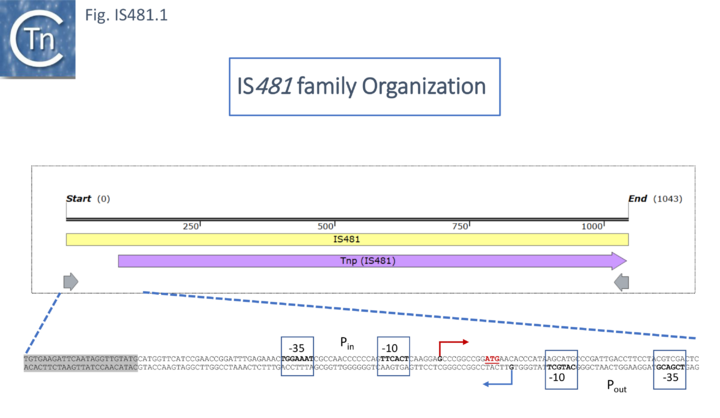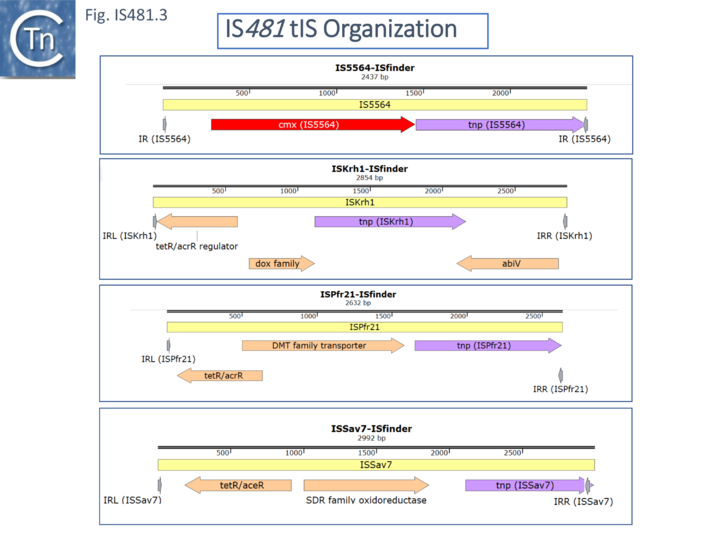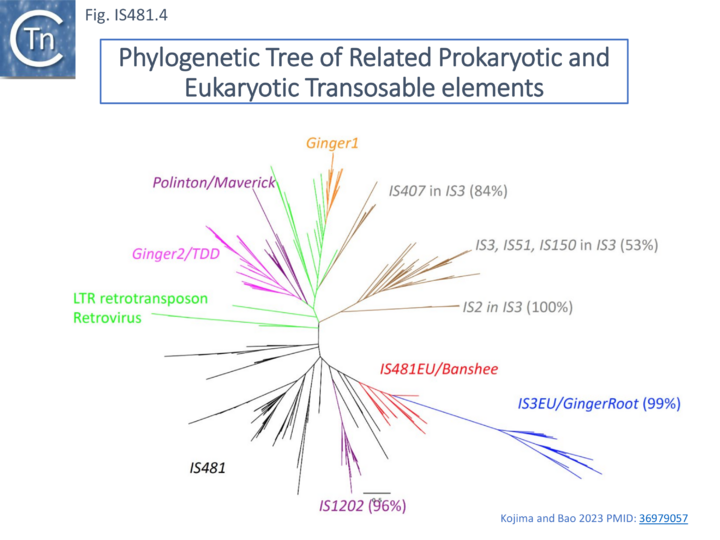IS Families/IS481 family
Contents
- 1 Historical
- 2 Relationship to other IS
- 3 Transporter (t)IS derivatives
- 4 Use of IS481 for Diagnostic Purposes
- 5 Relationship to Eukaryotic IS
- 6 IS481 in the Evolution of Bordetella
- 7 Genomic sequences, IS expansion, genome streamlining and decay
- 8 Changes at the gene level
- 9 IS impact on gene expression
- 10 Bibliography
Historical
IS481 was first identified in the late 1980s [1][2] as a repeated sequence in the agent of whooping cough, Bordetella pertussis. It was estimated, from Southern blots of restriction digested B. pertusis genomic DNA, that IS481 was present in multiple copies of about 20, with some variation between strains. They were not observed as repeated sequences in the single strain of B. parapertussis or in B. bronchiseptica which were analyzed, although homology was observed as a single band in B. parapertussis strain BPAH1 genomic digests and two bands in digests of B. bronchiseptica strain BBRH1.
The DNA sequence [2][3][4] later identified IS481 as a 1052bp element with 28bp terminal inverted repeats and confirmed that it was not present in multiple copies in either theB. parapertussis or B. bronchiseptica genomes. This was later reassessed to be 1046bp in length (Fig. IS481.1; [5]) and to massively hybridize with pertussis genomic DNA of 100 B. pertusis clinical isolates. There were a number of small sequence variations observed in the results from different authors.
It was also observed to transpose. When the bvgA gene, a global virulence regulator, was present as both a plasmid and chromosomal copy, host growth was inhibited when the plasmid-borne gene carries a small deletion [6]. Those derivatives in which growth inhibition was relieved had acquired IS481 insertions into the plasmid-borne gene or IS481/IS1002 insertions into the chromosomal gene and to generate 6bp target DR [7].

Relationship to other IS
Initially, IS481 appeared to be an IS3 family derivative which had been truncated for the N-terminal end of the Tpase and includes a C-terminal extension. The DDE active site domain and the IR (ending in 5’ TGT 3’) are similar to those of IS3 family members. Although, at that time IS481 had not been demonstrated to transpose, their presence in high copy number in some species and the identification of at least 130 distinct but related IS from over 90 species strongly suggested that these represent a distinct transpositionally active family. Different members generate DR of between 4 and 15 bp. Moreover, certain members (e.g. ISSav7) insert specifically into the tetranucleotide CTAG which becomes the flanking DR and provides the UAG termination codon for the Tpase. In contrast to the vast majority of IS3 family members, the IS481 Tpase is not produced by frameshifting. There is no evidence for a leucine zipper as in IS3. This can be clearly seen from the alignment and remarkable predicted structural similarities in the C-terminal catalytic domain and small N-terminal domain (Fig. IS481.2).
They also show a conserved 5’TG 3’ tip to the IR which is typical of this and a number of other types of prokaryotic mobile elements.
IS481 is also distantly related to the IS1202 family [9][10].

Transporter (t)IS derivatives
Some members carry passenger genes (Fig. IS481.3) including antibiotic resistance (CmR, cmx, for IS5564 and the closely related ISCgl1), or potential transcriptional regulators among other open reading frames (ISKrh1, ISPfr21- which contains a termination codon within the transposase, and ISSav7).

Use of IS481 for Diagnostic Purposes
There are PCR diagnostic clinical protocols for Bordetella based on IS481 [12][13][14] although several instances of false positive results have been reported.
Relationship to Eukaryotic IS
IS481 family IS are distantly related to the eukaryotic Banshee transposon which at present is restricted to the anaerobic flagellated protozoan Trichomonas vaginalis [15][16]. They share the highly conserved Pfam integrase core domain identified in the IS3 family and retroviruses [17][18]. Kojima and Bao [16], have identified a number of related IS from Trichomonas vaginalis which they have called IS481EU.
Interestingly, these were not well separated from a group of IS3 family-related eukaryotic sequences they called IS3EU/GingerRoot (similarly to the prokaryotic relatives) (Fig. IS481.4). It would be interesting to determine whether IS481EU transpose using a dsDNA circular intermediate as do IS3 family members.

IS481 in the Evolution of Bordetella
IS481 itself has played a fundamental role in the evolution of the genomes of the Bordetellae. The genus Bordetella includes 16 named species (see Wigland et al [19]). Three of these, B. bronchiseptica, B. parapertussis and B. pertussis are closely related and colonize the mammalian respiratory tract. Of the three, B. bronchiseptica is thought to be ancestral to B. parapertussis and B. pertussis although B. parapertussis is more closely related to B. bronchiseptica than to B. pertussis [20]. While B. bronchiseptica can infect a number of mammals, B. pertussis is a strict human pathogen and B. parapertussis infects both humans and sheep.
More detailed analysis revealed a relative of IS481, IS1002, with identical IR but only 61.5% sequence identity [21] was present in B. pertussis and B. parapertussis strains from humans but absent in B. parapertussis isolated from sheep, suggesting that little or no transmission has occurred between sheep and humans.
It was postulated that, once in the human host, B. parapertussis probably acquired IS1002 from B. pertussis. In contrast to human B. parapertussis, isolates, B. pertussis strains produced polymorphic IS1002-related DNA fingerprint patterns [21].
Genomic sequences, IS expansion, genome streamlining and decay
A remarkable result came from a comparison of the whole genome sequences of the three Bordatellae: B. bronchiseptica RB50; B. parapertussis 12822); and B. pertussis Tohama I [22] (Fig. IS481.5) showing a large expansion in one particular IS, IS481 accompanied by generation of an extensive collection of pseudogenes.
This analysis confirmed that B. parapertussis and B. pertussis are independent derivatives of B. bronchiseptica-like ancestors [23]. Indeed, it has even been proposed that B. pertussis has evolved from a human-associated B. bronchiseptica lineage [24]. Moreover, the process was driven by prophage loss from B. bronchiseptica and a massive amplification of IS481/IS1002 copies (261 in B. pertussis and 112 in B. parapertussis; [25]) accompanied by significant genome reduction and extensive gene inactivation and loss (Fig. IS481.5) and in the two host-restricted species. Although there are a number of collinear regions between B. bronchiseptica and B. parapertussis, most of the rearrangements involve either IS1001 or the IS481-related IS1002.
The rearrangements and deletions in B. pertussis were similar to those in B. parapertussis but more extreme. Short, highly conserved, segments were observed to be fragmented into ~150 individual rearrangements, with the vast majority (88%) bounded primarily by copies of IS481. Thus, the authors point out, adaptation to specific hosts results in loss rather than gain of function. A study which also included B. holmesii found that inversions in the genomes of B. holmesii, B. pertussis, and B. parapertussis were generally flanked by the multicopy IS which occur in their genomes [26].
Changes at the gene level
There is little net gain of genes in the host restrictive species: very few genes were present in B. pertussis and B. parapertussis but missing in B. bronchiseptica RB50. On the other hand, B. bronchiseptica had over 600 genes not present in either of the other two species: over 1,000 were shared only with B. parapertussis while just over 100 were shared only with B. pertussis. Moreover, IS expansion was accompanied by a large increase in the number of pseudogenes (Fig. IS481.5).
IS impact on gene expression
It was suggested that IS481 might play an important functional role for B. pertussis in facilitating its adaptation to new environmental conditions by controlling characters such as phase variation and production of virulence determinants. In this light, IS481 was shown to drive expression of the catalase gene katA in strain BP504 (DeShazer et al 1994 PMID: 7830550) and the type III cytotoxic effector gene bteA, responsible for host cell death in Bordetella bronchiseptica infections in the vaccine-derived strain BP155 (Han et al., 2011 PMID: 21423776).
A more recent study (Amman et al., 2018 PMID: 29683387) addressed the global impact of IS on the the B. pertussis transcriptome due to the presence of IS-associated promoters (Fig. IS481.1 bottom) or the formation of hybrid promoters on insertion (see refs). This study revealed that that most IS481 elements impact the transcriptional level of their flanking genes and can result in an uncharacterized regulation in a strain-specific manner due to significant strain to strain IS copy number variation and variations in their genomic context. Using the B. pertussis Tohama I strain the authors observed, from both RNA-seq and an approach to map transcriptional start sites (TSS), that a significant number of IS) generated transcripts into neighboring genes from a promoter at the left end (Fig. IS481.1; Fig.IS481.XXX) which they called Pout with reference to a similar promoter in IS10 which produces an RNA involved in regulation of transposase expression (IS10: Simmons et al 1983 PMID 6311437; Simons and Kleckner 1983 PMID: 6311438 ; Case et al., 1988 PMID: 2468561 ; Ma and Simons., 1990 PMID: 1691097; Case et al., 1990 PMID: 1691096) and in other IS (e.g. IS200 : Ellis and Haniford 2016, PMID: 26846462; ISPpu9: Gomez-Garcia et al 2021 PMID: 34379788).
Transcripts were identified extending into the flanking gene from Pout both in the “sense” orientation, potentially activating its transcription (70 IS: 66 copies of IS481 and 2 of IS1002 as well as 2 IS110 family IS1663), and in the antisense direction, potentially inhibiting expression (150 IS: 139 IS481copies, 2 of IS1002 and 9 IS110 family IS1663).
Many cases (97 IS481, 1 IS1002 and 3 IS1663) were observed where Pin-driven transposase transcription escapes into a downstream gene from the right end, in the same (46 times) or opposite (38 times) orientation.
Perhaps rather surprisingly, in view of their abundance in other systems (Vandecraen et al 2017 PMID: 28407717; Siguier et al 2014 PMID: 24499397), only 6 IS481 transcripts originated from a hybrid promoter in which the inserted IS provides a -35 promoter element to a endogenous -10 element.
The effects of these IS-associated transcripts on virulence, pathogenicity and persistence is gradually being assessed in detail. Pout had been identified by its ability to drive a neighboring katA gene in B. pertussis BP504 (DeShazer et al 1994 PMID: 7830550) and a bteA gene whose product is cytotoxic, in the vaccine-derived BP155 strain (Han et al. 2011. PMID: 21423776). Interestingly the IS481 insertion occurred in B. pertussis clinical strains and the protein was found at higher levels in B. pertussis nonvaccine-type strains than in vaccine-type strains. The type-dependent expression was due to an insertion of IS481.
Bibliography
- ↑ <pubmed>3426877</pubmed>
- ↑ 2.0 2.1 <pubmed>2888834</pubmed>
- ↑ 3.0 3.1 <pubmed>2908119</pubmed>
- ↑ <pubmed>2552259</pubmed>
- ↑ 5.0 5.1 <pubmed>2229381</pubmed>
- ↑ <pubmed>9573202</pubmed>
- ↑ <pubmed>9733704</pubmed>
- ↑ <pubmed>39781897</pubmed>
- ↑ <pubmed>37302728</pubmed>
- ↑ <pubmed>36880881</pubmed>
- ↑ <pubmed>15215455</pubmed>
- ↑ <pubmed>8370741</pubmed>
- ↑ <pubmed>38445858</pubmed>
- ↑ <pubmed>11326023</pubmed>
- ↑ <pubmed>18076328</pubmed>
- ↑ 16.0 16.1 16.2 <pubmed>36979057</pubmed>
- ↑ <pubmed>1963920</pubmed>
- ↑ <pubmed>1314954</pubmed>
- ↑ <pubmed>31744907</pubmed>
- ↑ <pubmed>3957867</pubmed>
- ↑ 21.0 21.1 <pubmed>8782670</pubmed>
- ↑ <pubmed>12910271</pubmed>
- ↑ <pubmed>3957867</pubmed>
- ↑ <pubmed>16389302</pubmed>
- ↑ <pubmed>15100691</pubmed>
- ↑ <pubmed>31744907</pubmed>
